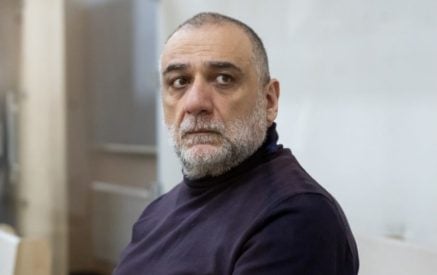A Canadian-Armenian composer Ashot Ariyan about his works, particularly, his opera-ballet “Bilgamesh”
The Canadian-Armenian composer Ashot Ariyan’s (in the photo) «Sounds of Stonehenge» Symphony painting, performed by the Armenian National Philharmonic Orchestra (conductor Harutyun Arzumanyan), attached great interest among the specialists in 2012. The author was presented to the Armenian audience only once so far. These days, the artist is again back to his homeland. In the meeting with “Aravot”, the composer said that some of his works can be seen in the performance “The Tow Suns” under Rudolf Kharatyan’s choreography, which premieres on May 27 at the National Opera House. “I am honored that my music has found a place next to the works of Mashtots, Narekatsi, Aram Khachaturian, Alan Hovhaness, Babajanyan and Terteryan,” said our interlocutor.
Then, he said that he met with Kharatyan in Canada, 5 years ago. He also ensured that on listening the «Sounds of Stonehenge» Symphony painting, the piano concerto, the “Toccata”, «PLANETE X» pour 7 instruments, “Dedication” for solo cello, the choreographer, asked for permission to use it in the “Two Suns” ballet. Ashot Ariyan informed that the mentioned works are recorded by the Canadian «ARKEA» renowned Chamber Orchestra, a Mexican cellist Sergei Kosemian, the Montreal Symphony Orchestra, and he, as a pianist (Ashot Areyan took piano classes in Yerevan with Elena Abajian and Ruben Saryan). The composer is also an author of the symphony and chamber works, including for the Quartet, Trio, choral works and more.
The musician studied at the Yerevan State Conservatory after Komitas, with Armen Smbatyan, and later at the Moscow State Tchaikovsky Conservatory, with Karen Khachaturian classes. To our curiosity that receiving a fundamental education, why once he left Armenia and settled in Canada, the composer first noted that the purpose was the defense of the doctoral thesis, the subject of which required a thorough investigation, and then detailed, “It was the year 2007. The Doctoral thesis was the “Bilgamesh” opera-ballet, which was based on the Sumerian and Babylonian mythology. To the point, the melodious sections are sounded in the Sumerian and Babylonian dead languages. I was greatly supported on this by the Toronto and Chicago Universities’ experts, as well as by the Armenian archaeologist Hamlet Martirosyan. Eventually, I achieved by Doctorial thesis in 2012. I should also mention that Rudolf Kharatyan’s support in the opera-ballet libretto was great.”
To the question about why the opera-ballet performance is not staged until now, the composer answered, “The negotiations are pending today, starting from Vancouver to Toronto. For me, the film director Atom Egoyan’s authoritative opinion was valuable. Probably you know that Egoyan is а music lover of an opera art, and lately, opera performances directed by him are staged one after the other. The filmmaker known in the Toronto Opera Theatre staged the performances of Wagner’s “The Valkyrie” and Richard Strauss “Salome” operas. My desire is great to have the premiere of the opera-ballet in Yerevan’s Opera Theatre.” Referring to the “Bilgamesh” opera-ballet, Ashot Ariyan noted that it also contains an Armenian theme and detailed, “This work presents our two mountains of Masis. Masis in Sumerian means a twin mountain, in the middle of which there are the gates leading to the underworld. And since on March 21, the sun rises from the Bagrevand province of Eastern Armenia and Vayk region of Western Armenia, right in the middle of the two mountains of Masis, the Sumerians believed that the gates leading to the underworld begin from there, which symbolizes the beginning of spring.”
To our observation that, in fact, the composer has chosen a complex creative path called an opera-ballet in the case when the majority of his Western colleagues nowadays prefer the easy path – the so-called show, Ashot Ariyan said the following, “I have chosen this topic being convinced that the old in the arts is destructive, whereas the ancient can somehow serve as a guidance, even playing the role of a savior. The opera-ballet included the rites of sacrificers, fighting dances, sexual initiation scenes … and eventually, death.”
Samvel DANIELYAN
“Aravot” daily




















































